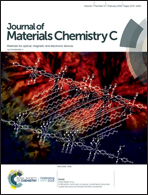Fabrication of high performance printed flexible conductors by doping of polyaniline nanomaterials into silver paste†
Abstract
Large-scale industrialization of flexible printed electronics will thrive on advanced functional conductive pastes with excellent properties such as high electrical conductivity and mechanical stability. Herein, we develop an effective method to simultaneously decrease the electrical resistivity and improve the mechanical stability of silver-resin-based conductors by adding a small amount of nanostructured polyaniline (PANI). PANI nanomaterials for improving the properties of conductive composites were synthesized by a facile and repeatable chemical oxidative polymerization method and characterized. Significant improvements in electrical performance were observed. For example, for the 60 wt% silver-filled flexible conductors, the addition of 0.5 wt% PANIs reduces their electrical resistivity to one-thirtieth (from 1253.1 × 10−5 Ω cm to 37.1 × 10−5 Ω cm). After adding 0.5 wt% PANIs, the bending stability (ΔR/R0) was also greatly improved from 92% to 2.3% (about 1/40th). Meanwhile, elastic conductors showed a much better performance in resistance stability and fatigue life (5 times longer than before) during stretching cycles after the addition of PANIs. A bendable printed circuit and a printed tensile resistive sensor were fabricated using the above PANIs to enhance conductive composites, which proved their potential applications in flexible printed circuits, stretchable pressure sensors, and e-skin or other fields.



 Please wait while we load your content...
Please wait while we load your content...